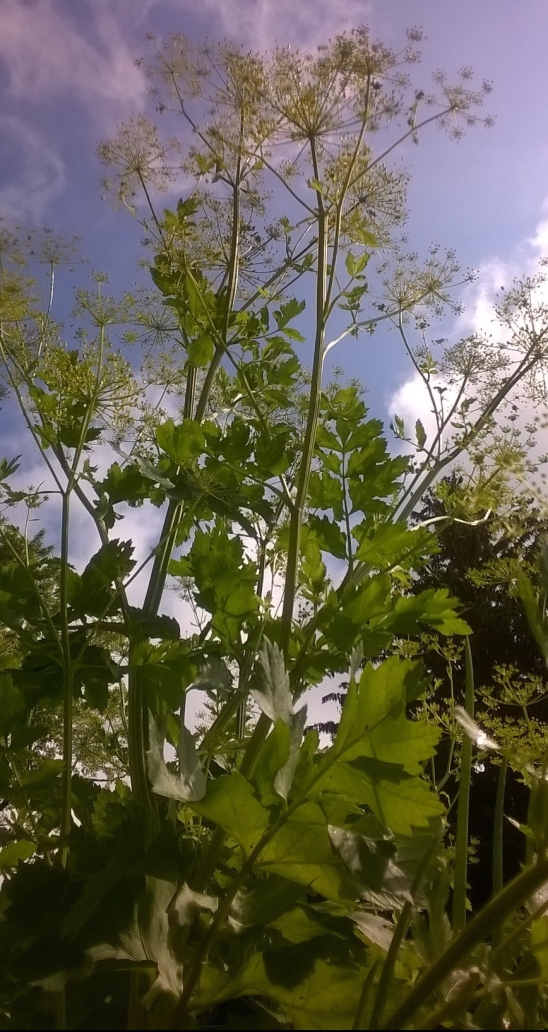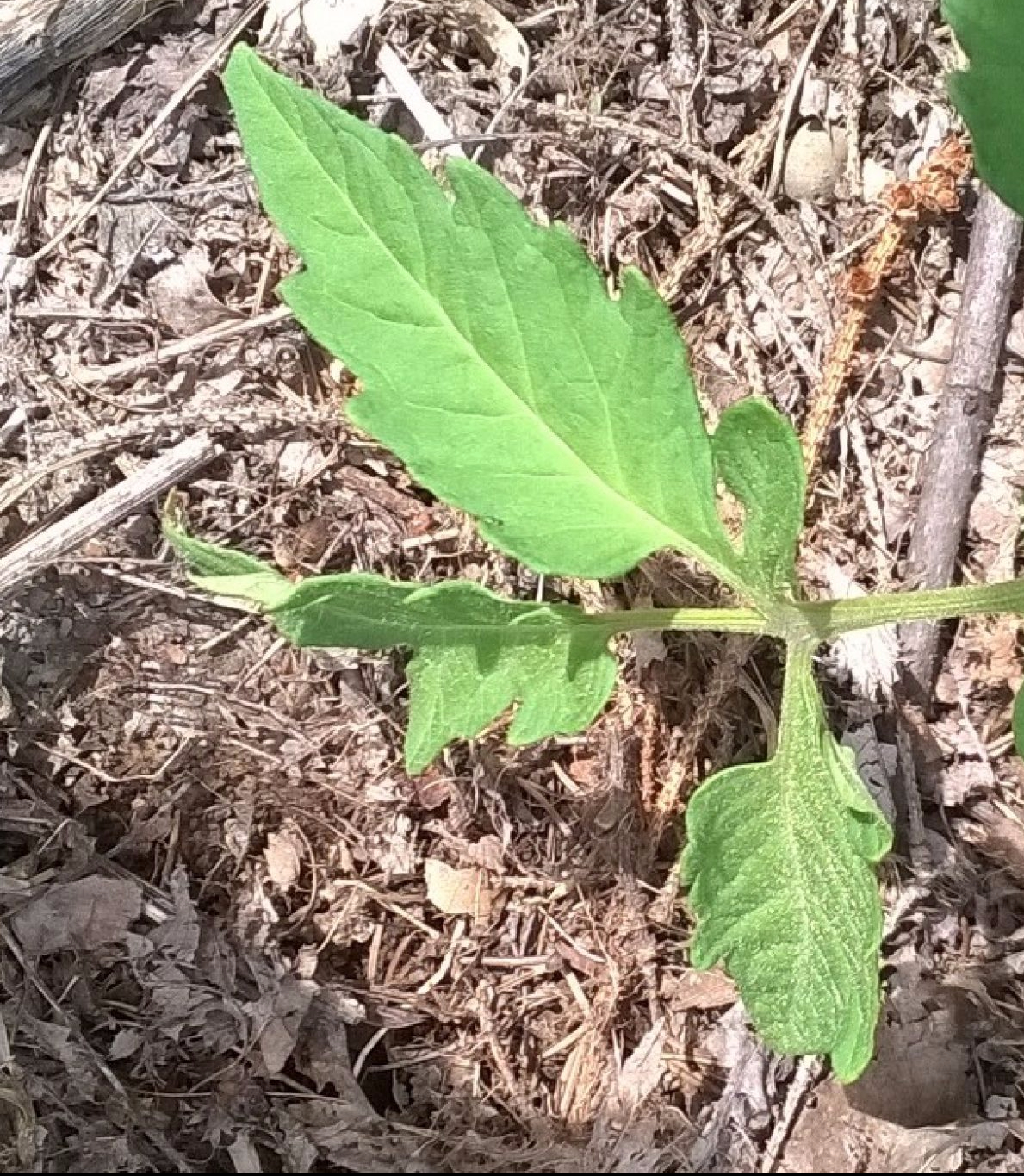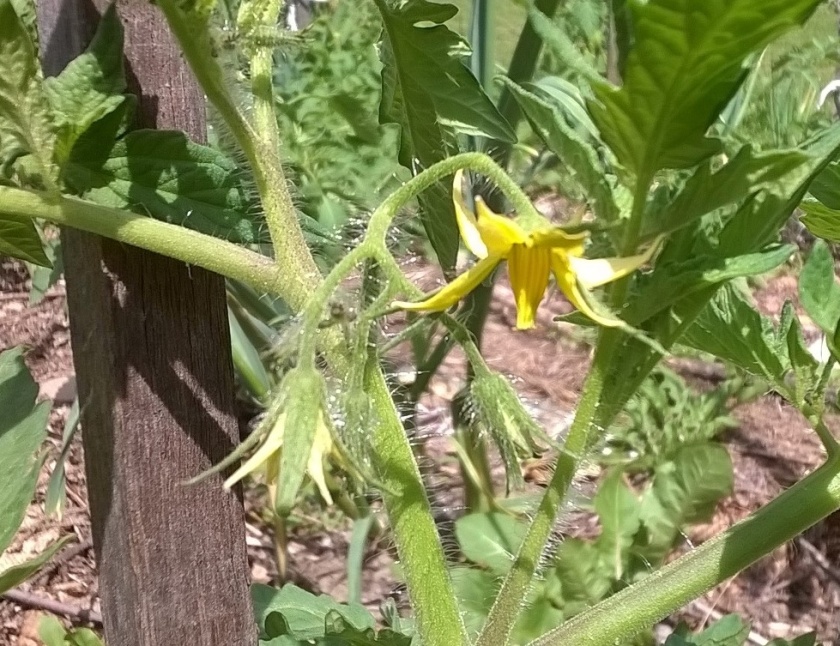Among my earliest memories is a recollection of my maternal grandfather walking through his vegetable garden while I followed happily along beside him. I remember that he was talking to me, though the words he was saying are beyond recall. It’s likely that he was explaining to me, in as much detail as he thought my little mind could grasp, the answers to my questions about the mysteries of the garden: why the cucumber vines were growing this way and not that way, why they were planted here and not there, how the bees could turn flowers into the fruit and vegetables we would eat.
I remember my grandfather pausing amid his tomato vines, which he kept tied up to wooden stakes. I had to tip my head back and look up to see their topmost leaves; they were that far above my head. Finding the right plant, my grandfather picked two red, ripe and, to my eyes, huge tomatoes, lovingly handing one of them to me. We left the garden then and headed inside to his kitchen. Sitting side by side at the table, we proceeded to indulge in what we both, and what I still do, consider the best conceivable way to eat a tomato: straight out of hand, whole, biting into it like an apple. My grandfather paused every few bites to sprinkle his with a bit of sugar; he always used sugar on his fresh tomatoes. I noticed, but didn’t care, that the juice from mine was running down my arm, all the way to my elbow, which made my grandfather laugh.
My mother and paternal grandmother were also gardeners, and I grew up thinking that vegetable gardening was just a thing that you did; it seemed as normal of a household activity as doing the laundry or sweeping the floor. I always assumed I would grow vegetables too once I moved out on my own. That was not to be the case for quite a few years, which I spent living in apartments, where gardening just wasn’t possible. Only once, for one short summer, was I fortunate enough to rent a place where I could have a small garden; all the other apartments didn’t allow for growing anything, other than a few herbs on the windowsill, and once or twice a tomato in a pot on the porch. There were several reasons why apartment living was advantageous to me, but I deeply missed having an outdoor space of my own. I wanted to walk barefoot through the morning dew, to poke under the previous autumn’s leaves covered with the last, thin patches of icy snow, looking for the first crocus awakening in spring, and, especially, to enjoy the incomparable taste of a fresh, sun-warmed tomato.
So, when it was finally time to buy a house, more than anything I looked forward to having a garden, and I was determined to find a place that had enough yard for good sized patch of vegetables. I initially wanted it to have a bit of land, but through an unusual series of events, I found a fantastic bargain, for a home in a nice suburban setting. The deal was too good to pass up, and it had a yard that seemed large enough for what I was then envisioning as my future garden.
I moved into my new home in early autumn and spent much of my free time that winter buying and devouring books on organic gardening, visiting a multitude of gardening websites, and requesting seed catalogs from companies across the country, and a few outside of it as well. I imagined my garden looking like the ones I saw in the garden books and website photos. It would be carefully laid out, I would lovingly maintain it, keeping it weed free and beautiful to behold. With delight, I started raising tomato, cucumber and zucchini plants indoors, so they would be ready for transplanting when the time arrived. As soon as it became feasible to do so, I gleefully dug up a patch of lawn, then planted lettuce, onions and peas. I threw myself into gardening with exuberance, and was richly rewarded with an abundance of delicious, healthy vegetables. I was hooked, and have been gardening every year since then.
I am not, by any means, an expert in gardening. I have no formal training in the matter, and no education in any agricultural science. But I have continued to try to learn everything I can on the subject, with the same zeal as I did that first winter. My interests have expanded since that time. I have gone from just wanting to raise organic vegetables to desiring a more sustainable lifestyle overall, and from simply gardening to taking some early steps into suburban homesteading. Every year, I have dug up a little more lawn in order to make more space for gardens. I have one large (compared to the size of the yard) in-ground garden for vegetables, and a few smaller in-ground patches for herbs and berries. The soil is very rocky here, making digging a new garden a laborious task, so I have added what my neighbor across the street calls “boxes” – small raised beds arranged in a rectangular pattern – that now take up much of the front lawn. Altogether, it doesn’t add up to a lot of space, but I have ideas for adding more, and I try to use what there is as efficiently as possible.
Now I must explain that, while I am not an expert in gardening, I am even less of an expert in organizational and time management skills, at least in my personal habits. I have the best of intentions, but other commitments must often take priority over gardening. When I have the time, there are always distractions calling me away from the gardening tasks I mean to complete, and somehow, the garden tool I need never seems to be where I think I last left it. Rarely, if ever, does my yard resemble the beautiful garden photos that I see in books or online. Without fail, every autumn, when I am feeling overwhelmed with the number of vegetables that need to be preserved and/or given away, I have vowed that I will not plant so much next spring. Every spring, I have vowed that I will figure out how to keep up with lawn mowing, trimming and weeding of the garden, and therefore it will be all right to plant as much – or more – than I did the previous year. And every summer, I have realized that I am not keeping those vows, as I have looked around at the lawn that has perpetually needed mowing, the weeds that have relentlessly invaded the flower beds, and the garden that has become a complete riot of wildly growing vegetables.
As I mentioned, my house is located in a suburban area, on a road where most residents recognize each other by sight, but know only their immediate neighbors by name. It’s the kind of place with lovingly maintained homes surrounded by neatly manicured lawns. Only a few gardens are visible from the road, and those are full of lovely flowers in artistically laid out patterns, carefully mulched and consistently free of weeds. They are gardens that do look like the pictures in books, all the time.
Fortunately, the neighborhood is also the kind of place where almost everyone is politely friendly and follows a mind-your-own-affairs philosophy, so no one complains about what I do with my yard. Yet, there is no denying that it is unquestionably the oddity of the neighborhood. The lady who lives directly across the street tells me that she likes to look at my place because, whenever she falls behind on her yardwork, seeing the condition of my yard makes her feel better about the state of her own. Neighbors, out for an evening stroll, will pause in front of my house, gaze at my garden, and talk quietly between themselves before walking on, sometimes smiling, and sometimes shaking their heads. If I happen to be in the front yard when they pass by, I will often find myself answering the question “what is that?” as they point to some lesser-widely-known vegetable (or weed) that happens to be growing. Currently, it’s one of last year’s parsnips, now four feet tall and about to blossom, that seems to be attracting the most attention.
Like many of the other residents in the area, I like to go for walks in the neighborhood, too. One time, I was passing by a home toward the end of the road, where the lady was out in front, digging a dandelion out of her lawn. We greeted each other and chatted briefly; I had seen her in her yard a few times, and she recognized me as someone that had passed by before, but didn’t know which house was mine. When I told her, she responded with “oh … yes, I know which house you mean.” After a few more pleasantries – the generic sort people exchange in such a situation – I continued on my way, and as I did, her husband came out of the house to join her. “Who was that?” I heard him ask her. There was the briefest of delays before she responded, “that … garden lady.” To be fair, she did not say the word ‘crazy,’ but I swear I could almost ‘hear’ her think it.




